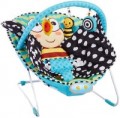Type
— Rocker. The distinctive feature of rockers as a type of swings is the adjustable backrest, which can be raised from lying to sitting position. The seat itself can be either adjustable or non-adjustable in tilt, but in any case the backrest and seat are adjusted separately. Rocker models can be used both for newborns and for older babies who are able to sit up on their own.
—
Bouncer. Chair bouncers differ first of all in that they do not have an adjustable backrest: only the tilt angle of the whole unit (backrest+seat) can be changed, and the unit itself is designed for lying down position of the child only. Thanks to the latter, all bouncers can be used from the first days of the baby's life; on the other hand, when the baby grows up and can sit up independently, the bouncer may not be so convenient.
—
Swing. Designs similar to classic children's swings: the seat unit is attached to a fixed stand and can swing back and forth thanks to movable fasteners (unlike other types that swing on curved skids, like classic rocking chairs). The advantage of the swing is the immobility of the base — they can be placed on any surface without fear of damaging it. On the other hand, swings take up significantly more space than other types. At the same time, there are models in which the seat unit can be removed and used separately as a rocking chair or bouncer (see above).
Weight limit
The maximum weight of a child that the swing can support without negative consequences in any position and in any mode of operation. A heavier child should not be placed: even if it does not break immediately, there is no guarantee that this will not happen at some point later, with unpleasant consequences for the child.
Foldable
The ability
to fold the swing for storage and transportation — in this sense, foldable models are much more convenient than non-foldable ones, because they take up less space. On the other hand, foldable swings are less durable and more prone to wear and tear; this does not affect the safety of use, but it can affect durability, especially with frequent folding/unfolding.
Backrest tilt adjustment
Possibility
of adjusting the backrest tilt of a swing. This adjustment is separate from the seat and provides the possibility to adjust the entire seat unit for both sitting and lying positions; in bouncers, the backrest tilt adjustment is performed simultaneously with the seat (see "Seat tilt adjustment").
Backrest tilt levels
The number of fixed positions in which the adjustable backrest of the swing can be installed (refer to "Backrest tilt adjustment"). Any adjustable backrest has at least two positions — lying and sitting, and the more levels of tilt — the more options you have for customizing the swing to maximize your baby's comfort.

